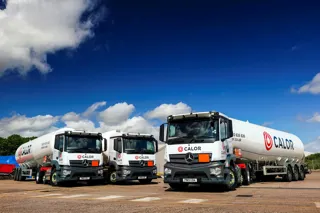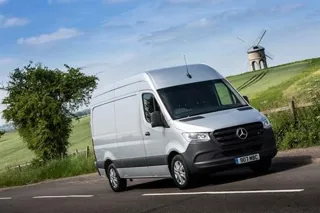Mercedes’ Citan has the worst emissions of the best-selling Euro 6 light commercial vehicles (LCVs) tested for the latest AIR Index.
The official NOx limit for the van is 105mg/km. According to the latest AIR Index test results, the actual urban NOx emissions were 902mg/km. This equates to 17 times more NOx than Volkswagen’s Crafter, one of the lowest emitters tested.
The AIR Index is an international, independent and standardised rating system that reveals accurately how much pollution a vehicle produces when it is used in towns and cities. The AIR Alliance commissioned tests for ten of Europe’s best-selling diesel light commercial vehicles using scientifically robust, on-road vehicle testing according to the latest CWA17379 methodology to give each vehicle a simple A-E colour-coded AIR Index rating, showing the difference between clean and dirty vehicles.
The index was created to inform and empower consumers, owner-drivers, fleet operators and policy makers with the real facts about emissions when making choices about vehicle purchase and usage.
Its latest round of testing saw the 2019 Volkswagen Crafter CR35 LWB High Roof 2.0 litre gain an ‘A’ rating on the AIR Index, emitting 53mg/km NOx, 72mg less than the large-van (Class III) laboratory-based legal limit of 125mg/km, with the 2019 Mercedes Citan 109 Blue Dualiner 1.5 litre is rated an ‘E’ on the AIR Index, emitting 902mg/km of NOx, more than 8 times the (Class II) light-van laboratory-based legal limit of 105mg/km.
Volkswagen’s 2018 Caddy C20 Highline TDI 2.0 litre and Peugeot’s 2019 Partner Asphalt 1.6 litre both get an ‘A’ rating, as their on-road emissions fall below the 80mg/km laboratory-based light van limit.
According to the AIR Index, however, the “power to dramatically and rapidly to improve emissions from dirty vans lies within the hands of the manufacturers”. For example, when it commissioned tests of the Mercedes Vito CDI 111 LWB 1.6, a simple “manufacturer-led update of the vehicle’s emissions management system halved the NOx emissions when tested again”. This would be the equivalent of improving the AIR Index rating from ‘D’ to ‘C’.
The results of the vans tested for AIR and rated on the AIR Index are:
|
Make |
Model |
Year |
AIR Index Rating |
Fuel Type |
Official NOx limit* |
Euro Standard |
Actual Urban NOx mg/km |
|
Volkswagen |
Crafter CR35 LWB High Roof 2.0 |
2019 |
A |
Diesel |
125 mg/km |
Euro 6 |
53 |
|
Volkswagen |
Caddy C20 Highline TDI 2.0 |
2018 |
A |
Diesel |
105 mg/km |
Euro 6 |
70 |
|
Peugeot |
Partner Asphalt 1.6 |
2019 |
A |
Diesel |
80 mg/km |
Euro 6 |
73 |
|
Volkswagen |
Transporter T30 Highline TDI Bluemotion 2.0 |
2018 |
B |
Diesel |
125 mg/km |
Euro 6 |
100 |
|
Mercedes |
Vito CDI 114 LWB 2.1 |
2017 |
B |
Diesel |
125 mg/km |
Euro 6 |
147 |
|
Ford |
Transit Custom 300 Limited 2.0 |
2019 |
C |
Diesel |
125 mg/km |
Euro 6 |
260 |
|
Vauxhall / Opel |
Vivaro CDTI 2900 1.6 |
2019 |
D |
Diesel |
105 mg/km |
Euro 6 |
401 |
|
Citroen |
Relay L3H2 Enterprise BlueHDi 2.0 |
2018 |
D |
Diesel |
125 mg/km |
Euro 6 |
557 |
|
Mercedes |
Vito CDI 111 LWB 1.6 (pre-update) |
2017 |
D** |
Diesel |
125 mg/km |
Euro 6 |
566 |
|
Mercedes |
Citan 109 Dualiner 1.5 |
2019 |
E |
Diesel |
105 mg/km |
Euro 6 |
902 |
* Official NOx limit refers to the in-laboratory Euro standards, and NOx limits for vans vary according to vehicle by classification by weight, eg Euro 6 Class I = 80 mg/km, Euro 6 Class II = 105 mg/km, Euro 6 Class III = 125 mg/km
** provisional rating
Massimo Fedeli, co-founder and operations director, AIR said: “Light commercial vehicles play a vital role in moving goods quickly and efficiently around our cities and beyond. With the growth in internet shopping and the general Amazonisation of retail, they are an ever-increasing part of our transport network and it’s crucial that only the cleanest vans are allowed to enter urban areas.
“As the AIR Index revealed when we tested the real-world NOx emissions of passenger cars, there is a shocking variation in actual emissions compared with the official results based on laboratory tests.
“AIR is calling on cities to supplement the use of Euro 6 standards for low emission zone entry – such as London’s own ULEZ – with the AIR Index database of real-world emissions results, to identify the dirtiest vans which are otherwise slipping through the net. By doing so, we believe the AIR Index could very quickly bring most European cities in line with air quality targets.”
Nick Molden, co-founder of AIR, said: “The results of these van tests for the AIR Index continue to hammer home the fact that current policy can’t do enough to prevent damage from high emitters and treat low emitters more fairly. This is impacting air quality across in cities across Europe and is potentially costing many thousands of lives. The AIR Index gives policy makers and fleet managers information they’ve never had before enabling informed decisions about the consequences of vehicle choice.
“The ten Euro 6 diesel vans we tested represent just under half of the annual sales across Europe. If just those rated D or E were prevented from entering the centre of urban areas the AIR Index could bring all European cities into air quality compliance.
“But the ultimate responsibility to implement change lies with the manufacturers. With simple service-led engine management updates, it is possible to make vans much cleaner, dramatically reducing emissions immediately.”























Barry Jillett - 04/08/2020 22:15
I figure the test was done with a Citan with the old engine OM607 as my Citan 109 Van uses new OM608 engine and needs adblue and is Euro 6D temp